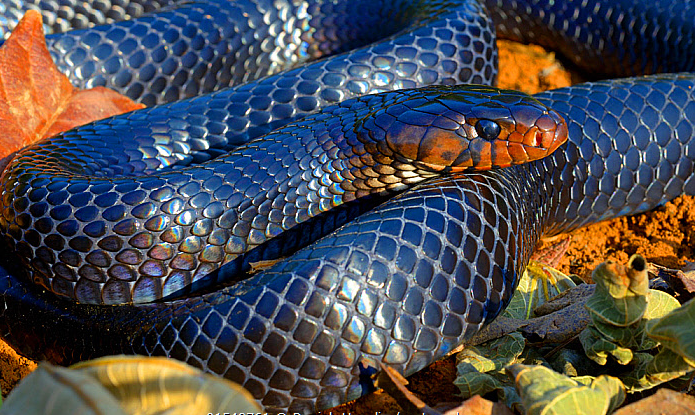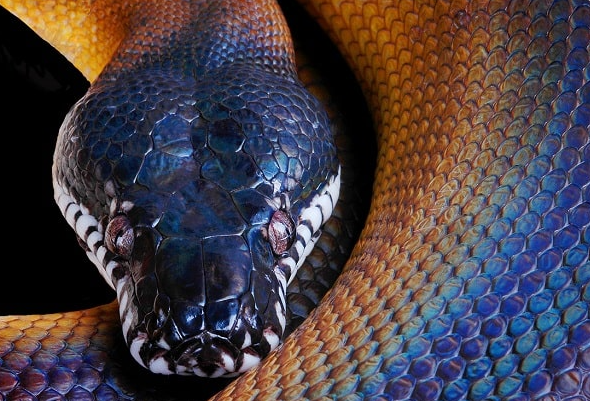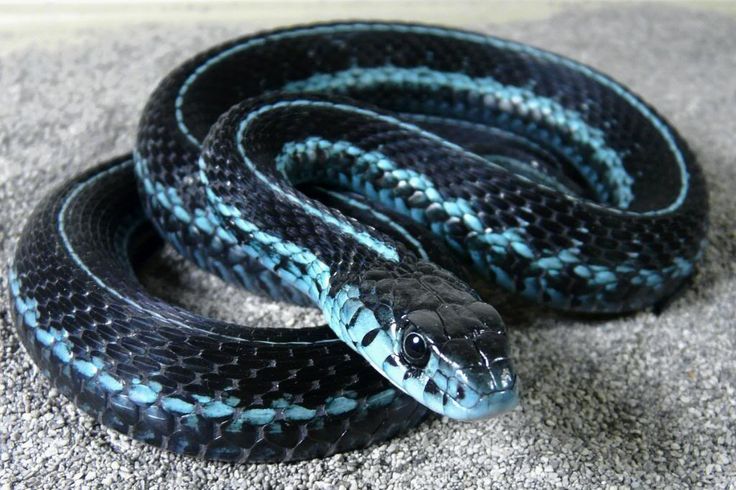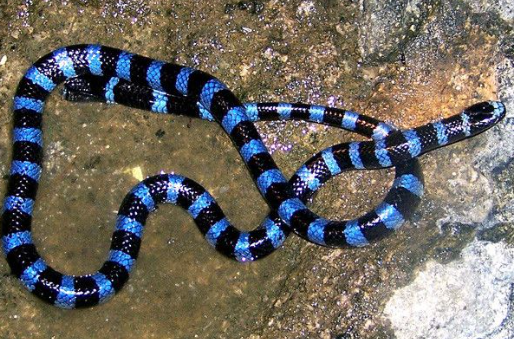In nature, most snakes are known for their earth-toned camouflage, which helps them blend into their natural environments. However, there are snakes with unique colors and patterns either as a result of genetic variations, environmental factors or specific adaptations.
While blue is not a common color among snakes, there are some species that exhibit shades of blue in their appearance. Blue snakes can be found from Southeast Asia, Africa to the arid landscapes of North America. In many places, these snakes are popular in the pet trade.
Not all blue-colored snakes are harmless. Some venomous snakes also exhibit blue coloration, just as a warning signal to potential predators.
Always exercise caution and seek expert guidance when encountering snakes, especially those in their natural habitats, to ensure a safe and respectful interaction. Let us talk about different types of blue snakes, their characteristics and where they’re generally found.
Common Blue Snakes
- Red-headed reed snake (Calamaria schlegeli)
- Blue Coral Snake (Calliophis bivirgata)
- Blue Racer Snake (Coluber constrictor foxii)
- Eastern Indigo Snake (Drymarchon couperi)
- D’Albertis’ python (Leiopython albertisii)
- Blue Beauty Snake (Orthriophis taeniurus callicyanous)
- Puget Sound Gartersnake (Thamnophis sirtalis pickeringii)
- Blue-Lipped Sea Krait (Blue-Banded Sea Krait)
- White-Lipped Island Pit Viper/ Sunda Island Pit Viper (Trimeresurus insularis)
- Bluestripe ribbon snake (Thamnophis saurita nitae)
Description
Blue Coral Snake (Calliophis bivirgata)

The blue coral snakeor blue Malayan coral snake belongs to the family Elapidae, which includes venomous snakes like cobras and kraits.
This snake is native to Southeast Asia, including countries like Thailand, Malaysia, Indonesia, and parts of Cambodia and Vietnam.
Adult Blue Coral Snakes are relatively slender, with a length ranging from 1.2 to 1.5 meters on average. Some individuals can reach lengths of up to 2 meters.
It has a red head, tail and belly. The back is dark blue to black in color, and it usually has a large blue or white stripe on each flank.
The snake, especially when young its appearance can easily be confused with that of pink-headed reed snake (Calamaria schlegeli). The reed snake is nonvenomous, while the coral snake is venomous, possessing potent neurotoxins.
In South East Asia, this uncommon snake can be found in lowland rainforests and adjacent areas. It preys on other snakes. When threatened it usually flees, but it may remain in place with its red tail erect as a defensive message.
Blue Racer Snake (Coluber constrictor foxii)

The Blue Racer Snake is a non-venomous subspecies of the Eastern Racer (Coluber constrictor). This snake is commonly found in parts of the central United States, particularly in the Great Lakes region.
Adult Blue Racers has a slender and elongated body, with smooth scales and a bluish glossy appearance. It can be 3 to 5 feet in size, with males generally being smaller than females.
The blue color is most prominent in younger individuals, and as the snake matures, it may develop a more olive or yellowish tint.
The head is usually darker than the body, and there may be a faint pattern of darker scales running down the back.
In parts of South Dakota, Wisconsin, Illinois, and Michigan, down to Missouri and Indiana. This snake can be found mostly grasslands, prairies, meadows, and open woodlands.
They are good climbers and are usually observed basking in elevated positions. When threatened, these snakes are quick to flee and may emit a strong, musky odor as a defense mechanism.
Adults engage in both terrestrial and arboreal foraging. Blue racers are diurnally active.
Probable natural predators of adult blue racers include the larger birds of prey (e.g., red-tailed hawk, northern harrier, great horned owl) and carnivorous mammals such as raccoons, foxes and coyotes.
Eastern Indigo Snake (Drymarchon couperi)

The Eastern Indigo Snake (Drymarchon couperi) is a nonvenomous species of colubrid snake native to the southeastern United States (Alabama, Arkansas, Florida, Georgia, Kentucky, Louisiana).
Adults can reach lengths of 6 to 8 feet, with some individuals exceeding 9 feet. They are the longest snake species in North America.
Its color is uniformly a lustrous black (blue-black), although the chin, throat, and sometimes the cheeks may be red to creamy in color. Young ones may have more vivid markings that fade as they mature.
The scales of the Eastern Indigo Snake are smooth, giving it a shiny appearance.
Although their populations have declined in some areas. Their habitats, include longleaf pine forests, pine flatwoods, scrublands and coastal hammocks.
In the northern range of their territory they require sheltered retreats from winter cold and desiccating conditions and often coexist with gopher tortoises inside their burrows.
In wetter habitats that lack gopher tortoises, eastern indigo snakes may take shelter in hollowed root channels, hollow logs, or the burrows of rodents, armadillo, or land crabs.
As an apex predator, indigo snakes have no natural predators. Instead, humans represent the biggest threat to the eastern indigo snake. Highway fatalities and wanton killings have adversely affect indigo snake populations.
The eastern indigo snake has a number of common names including indigo snake, blue indigo snake, black snake, blue gopher snake, and blue bull snake.
D’Albertis’ python (Leiopython albertisii)

D’Albert’s water python or the northern white-lipped python, is a species of Python. The species is endemic to New Guinea. There are no recognized subspecies of Leiopython albertisii.
Adult females of D’Albert’s water python can grow to an average length of about 213 cm (6–7 ft), including the tail.
Both male and female individuals are patternless, except for some light markings on the postocular scales (scales around the eyes). The dorsum (upper surface) of the head is shiny black.
The upper and lower labial scales (lip scales) are white with black markings on the anterior edge of the scales. Body color can be brownish-violet fading to yellowish ventrally or blackish-blue fading to gray.
As a member of the Pythonidae family, D’Albertis’ python is a non-venomous snake that relies on constriction to subdue its prey.
Within New Guinea, these pythons can be found in forests and other areas covered with vegetation. Their specific distribution within the island may vary, and they may inhabit different ecological niches depending on factors such as altitude, climate, and vegetation types.
Blue Beauty Snake (Orthriophis taeniurus callicyanous)

Blue Beauty Snake also referred to as Blue beauty rat snake is a non-venomous colubrid snake that is native to southeastern regions of Asia (Thailand, Cambodia, Vietnam and Laos).
The snake is characterized by its vivid blue color, which is highly distinctive. The blue hue can be light to deep shades. Black markings or patterns often adorn the blue background.
These snakes have a slender and elongated body, typical of colubrids. It can reach lengths of around 4 to 6 feet (1.2 to 1.8 meters) on average, with males being smaller than females. The scales are smooth, and the head is distinguishable from the body.
These snakes are often found in forested areas, preferring habitats with vegetation. They may also be located in grasslands and agricultural areas.
Blue Beauty Snakes are generally calm and docile in behavior, but individual temperament can vary. Like other snakes, when handled regularly when young, they become well acclimated to humans and are not aggressive.
In the wild, their diet consists of small mammals, birds, and occasionally other reptiles.
Puget Sound Gartersnake (Thamnophis sirtalis pickeringii)

Thamnophis sirtalis pickeringii is a subspecies of the common garter snake (Thamnophis sirtalis) found in the Pacific Northwest of North America. Its range is specifically associated with the Puget Sound region in Washington state.
The base color of the snake is deep black, and the three longitudinal stripes are slightly bluish yellow and in some species the stripes take on a beautiful blue color.
Adult males measure around 70 to 80 cm in length and have a relatively slender build. Females become significantly larger and heavier, with a normal length ranging from 80 to 100 cm.
Like other garter snakes, Thamnophis sirtalis pickeringii is likely to be found in habitats like grasslands, woodlands and wetlands. Garter snakes can often be seen near water sources, as they like to feed on amphibians and small fish.
Blue-Lipped Sea Krait (Blue-Banded Sea Krait)

The blue-lipped sea krait, also known as the blue-banded sea krait or common sea krait, is a species of venomous sea snake. In other words, it is a snake that spend most of its time in the water.
It is found in the warm tropical waters of the Indian and Pacific Oceans. Their range includes coastal areas, coral reefs, and shallow waters around islands in regions such as Southeast Asia, the Bay of Bengal, northern Australia, and parts of the Pacific.
Sea kraits have a black or dark blue body marked by light blue bands or rings. They too have a short head, small black eyes, and a flattened tail.
The most notable feature is the bright blue color of their lips, from which their name was derived. Adult grow to lengths between 0.8 to 1.2 meters (2.6 to 4 feet). Males are usually smaller than females.
Blue-Lipped Sea Kraits are venomous, and their bite can be dangerous to prey. However, they are not considered aggressive toward humans and rarely pose a threat unless provoked.
Sea kraits are active at night, spending much of the time searching in the water for eels or small fish. Striking swiftly, the sea krait grasps its prey with its fangs until its venom has paralyzed its prey.
White-Lipped Island Pit Viper (Trimeresurus insularis)

White-lipped Island Pit Viper is a venomous pit viper species found in eastern Java and the Lesser Sunda Islands, Indonesia. It is also found in Malaysia and surrounding regions.
The snake is named because of the white color around its lips. Their color patterns are often found to be green or a blue-green color with specific populations even containing yellow variants as well
The head may have a triangular shape, common in pit vipers. Adult White-Lipped Island Pit Vipers are generally moderate in size, with lengths ranging from approximately 50 cm (20 inches) to around 80 cm (32 inches).
This species is primarily arboreal. It spends much of its time in trees. It can be found in various forested habitats, including rainforests and wooded areas on islands.
Like many pit vipers, Trimeresurus insularis is considered an ambush predator. It often waits patiently for prey, which may include small mammals, birds, and lizards, to come within striking distance.
Also goes by the name: Indonesian pit viper, Lesser Sunda Islands pit viper, Sunda white-lipped pit viper, red-tailed pit viper.
The bluestripe ribbon snake (Thamnophis saurita nitae)

The bluestripe ribbon snake is a subspecies of the ribbon snake that occurs along the Gulf Coast in Florida. Generally, its range extends from Florida in the south, northward to New England, and westward to parts of the Midwest.
They are semi-aquatic and are active during the day. They can be found by lakes, rivers, and slow-moving streams.
Adults are thin and are black with a mid-dorsal stripe that is a lighter shade of black and two blue stripes, hence the name “bluestripe ribbon snake”.
Adult Eastern Ribbon Snakes are generally small to medium-sized, with lengths ranging from 16 to 38 inches (40 to 97 cm).
The diet of these Snakes consists of amphibians like frogs and tadpoles. They may also eat small fish and invertebrates.
Eastern Ribbon Snakes give birth to live young rather than laying eggs. The number of offspring in a single litter can vary but is usually between 5 and 25.
Red-headed Reed Snake (Calamaria schlegeli)

The Red-headed Reed Snake is found in parts of Southeast Asia. Its range includes countries like Thailand, Brunei, Malaysia, Indonesia, and Singapore. It is a small, lustrous, non-venomous snake.
The snake is named because of its red coloration on its head. The body color is generally blue-black or brown.
Adult Red-headed Reed Snakes are usually small, with total lengths ranging from 20 to 30 centimeters (8 to 12 inches).
The species is known commonly as the red-headed reed snake, white-headed reed snake, and pink-headed reed snake.
As with other Reed Snakes this species is a burrowing forest dweller, which feeds on small invertebrates such as worms, sometimes emerging at night to take insects.
These snakes are primarily associated with wetland habitats, including marshes, swamps, and areas with dense vegetation. They are often found in or near water.
Red-headed Reed Snakes are primarily terrestrial but may be adept climbers.
This nonvenomous red-headed snake is sometimes confused with the blue Malayan coral snake (Calliophis bivirgatus) and the red-headed krait (Bungarus flaviceps), which are venomous.